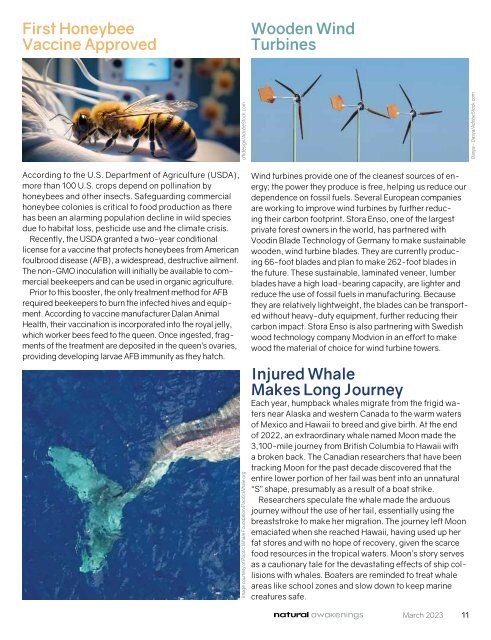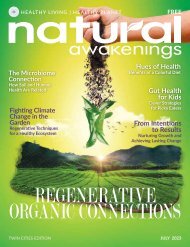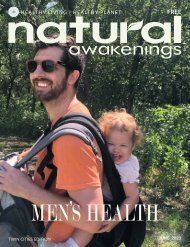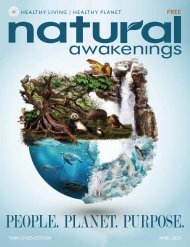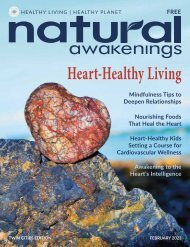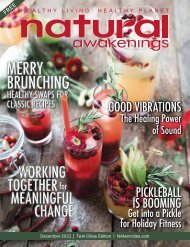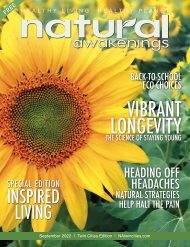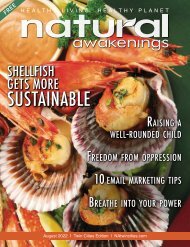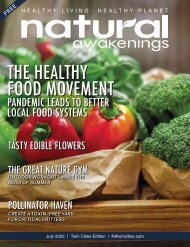Natural Awakenings Twin Cities March 2023
Read the March 2023 edition of Natural Awakenings Twin Cities magazine. This is our annual Food and Nutrition Issue which features articles on plant-based resources, veggies for the win, supplements that help the heart, organs of detoxification, health coaching, releasing emotional baggage, human-grade dog foods, eco-friendly water heating and so much more! Be sure to check out our local content, including News Briefs announcements, Community Resource Guide with providers throughout the metro who can meet your individual wellness needs, and all the happenings in the Calendar of Events. There is additional online-only content that can be found at NATwinCities.com.
Read the March 2023 edition of Natural Awakenings Twin Cities magazine. This is our annual Food and Nutrition Issue which features articles on plant-based resources, veggies for the win, supplements that help the heart, organs of detoxification, health coaching, releasing emotional baggage, human-grade dog foods, eco-friendly water heating and so much more!
Be sure to check out our local content, including News Briefs announcements, Community Resource Guide with providers throughout the metro who can meet your individual wellness needs, and all the happenings in the Calendar of Events. There is additional online-only content that can be found at NATwinCities.com.
Create successful ePaper yourself
Turn your PDF publications into a flip-book with our unique Google optimized e-Paper software.
First Honeybee<br />
Vaccine Approved<br />
Wooden Wind<br />
Turbines<br />
cfhdesign/AdobeStock.com<br />
Dasya - Dasya/AdobeStock.com<br />
According to the U.S. Department of Agriculture (USDA),<br />
more than 100 U.S. crops depend on pollination by<br />
honeybees and other insects. Safeguarding commercial<br />
honeybee colonies is critical to food production as there<br />
has been an alarming population decline in wild species<br />
due to habitat loss, pesticide use and the climate crisis.<br />
Recently, the USDA granted a two-year conditional<br />
license for a vaccine that protects honeybees from American<br />
foulbrood disease (AFB), a widespread, destructive ailment.<br />
The non-GMO inoculation will initially be available to commercial<br />
beekeepers and can be used in organic agriculture.<br />
Prior to this booster, the only treatment method for AFB<br />
required beekeepers to burn the infected hives and equipment.<br />
According to vaccine manufacturer Dalan Animal<br />
Health, their vaccination is incorporated into the royal jelly,<br />
which worker bees feed to the queen. Once ingested, fragments<br />
of the treatment are deposited in the queen’s ovaries,<br />
providing developing larvae AFB immunity as they hatch.<br />
Image courtesy of Pacific Whale Foundation/PacificWhale.org<br />
Wind turbines provide one of the cleanest sources of energy;<br />
the power they produce is free, helping us reduce our<br />
dependence on fossil fuels. Several European companies<br />
are working to improve wind turbines by further reducing<br />
their carbon footprint. Stora Enso, one of the largest<br />
private forest owners in the world, has partnered with<br />
Voodin Blade Technology of Germany to make sustainable<br />
wooden, wind turbine blades. They are currently producing<br />
66-foot blades and plan to make 262-foot blades in<br />
the future. These sustainable, laminated veneer, lumber<br />
blades have a high load-bearing capacity, are lighter and<br />
reduce the use of fossil fuels in manufacturing. Because<br />
they are relatively lightweight, the blades can be transported<br />
without heavy-duty equipment, further reducing their<br />
carbon impact. Stora Enso is also partnering with Swedish<br />
wood technology company Modvion in an effort to make<br />
wood the material of choice for wind turbine towers.<br />
Injured Whale<br />
Makes Long Journey<br />
Each year, humpback whales migrate from the frigid waters<br />
near Alaska and western Canada to the warm waters<br />
of Mexico and Hawaii to breed and give birth. At the end<br />
of 2022, an extraordinary whale named Moon made the<br />
3,100-mile journey from British Columbia to Hawaii with<br />
a broken back. The Canadian researchers that have been<br />
tracking Moon for the past decade discovered that the<br />
entire lower portion of her tail was bent into an unnatural<br />
“S” shape, presumably as a result of a boat strike.<br />
Researchers speculate the whale made the arduous<br />
journey without the use of her tail, essentially using the<br />
breaststroke to make her migration. The journey left Moon<br />
emaciated when she reached Hawaii, having used up her<br />
fat stores and with no hope of recovery, given the scarce<br />
food resources in the tropical waters. Moon’s story serves<br />
as a cautionary tale for the devastating effects of ship collisions<br />
with whales. Boaters are reminded to treat whale<br />
areas like school zones and slow down to keep marine<br />
creatures safe.<br />
<strong>March</strong> <strong>2023</strong><br />
11


